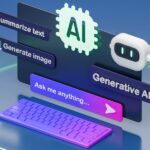By: Paul Anthony Claxton
Right now artificial intelligence (AI) is a lot living in a barren desert. How, you might ask? In several key ways, such as the following:
| DESERT | AI |
| Lack of water, although there are ways to harness this | Lack of data, although there are ways to harness this |
| Hundreds of use cases to make the desert more livable and sustainable | Hundreds of use cases for AI to help make our existence more livable and sustainable |
| Many, many threats to livelihood, but on the contrary, many opportunities to support livelihood | Many, many threats to livelihood, but on the contrary, many opportunities to support livelihood |
Let’s dig into some of these side-by-side comparisons to help us understand both some of the challenges and opportunities we face in the plight of progressing AI forward.
1. Lack of Resources (Water vs. Data)
Desert
Deserts are notoriously dry, with scarce water resources. Despite this limitation, there are innovative solutions such as desalination, rainwater harvesting, and the use of solar energy to power irrigation systems that can help harness the water that exists and make these regions more habitable.
AI
Similarly, in the world of AI, one of the biggest barriers is the lack of high-quality, structured data. Data is the “water” of AI—without it, AI models cannot grow and thrive. However, there are ways to overcome this, such as leveraging synthetic data, developing more efficient data collection methods, or using advanced algorithms that can work with minimal data inputs. Just as people have found ways to extract water in the desert, data scientists and AI engineers are constantly developing methods to “mine” useful data from sparse environments.
We need water, so why don’t we just dig up all the cactuses to extract the water?
In both the desert and AI, “digging up all the cactuses” represents a shortsighted, potentially destructive approach. In the desert, this means removing key elements of the ecosystem that support life, leading to greater challenges down the road. Similarly, in AI, it means disrupting important components like ethical guidelines, regulatory frameworks, or data diversity, leading to long-term harm in the endeavor to get data at all costs.
For example, the Sonoran Desert, spanning parts of the southwestern United States (mainly Arizona and California) and northwestern Mexico, covers approximately 100,000 square miles.
The cactuses of the Sonoran Desert, particularly the iconic saguaro, have the potential to store a significant amount of water, with a single mature saguaro holding between 750 to 2,000 liters. Estimates suggest that the desert contains tens of millions of cactuses, including around 10 million saguaros. With each cactus averaging about 1,000 liters of water, this would amount to roughly 10 billion liters. Given that a person in a desert environment requires around 1,500 liters of water annually, this volume could theoretically support around 6.67 million people for a year. However, the extraction of water from cactuses would be impractical, as they require the water for their own survival, and large-scale harvesting would devastate the desert ecosystem. Additionally, the water inside cactuses is not readily drinkable and contains compounds that could be harmful if consumed in large quantities. We have only been talking about drinking water. For more realistic total water needs in a sustainable living context, the total volume of water stored in the cactuses would support far fewer people. If we used the more comprehensive estimate of 55,000 liters per year per person, those 10 billion liters could only support around 182,000 people for a year rather than 6.67 million. Therefore, while the cactuses store a considerable amount of water, it is not a viable or sustainable solution for human water needs.
The approach would devastate the ecosystem, as cactuses play a critical role in supporting local wildlife and stabilizing the environment.
This scenario mirrors the current erroneous approach to AI-generated data. AI can produce massive amounts of raw information, much like how cactuses hold water, but this data is typically unrefined, requires filtering, and may even be harmful if misused or misunderstood. Without proper context, validation, and ethical considerations, relying on AI to deliver insights can lead to flawed decisions, just as relying on cactuses for water could lead to environmental destruction. Both examples illustrate how a focus on short-term gains—whether from AI data or natural resources—can lead to negative consequences if not handled thoughtfully and sustainably. The need for nuance,context, and long-term thinking is really imperative in both cases to prevent harm and maximize the benefits of the resources at hand.
2. Countless Possibilities (Use Cases)
Desert
Despite the challenging environment, there are hundreds of use cases that make deserts more livable and sustainable. From solar farms that take advantage of abundant sunlight to greenhouses that allow for the growth of crops in arid conditions, innovation is transforming deserts into viable living spaces.
AI
Similarly, AI offers a tremendous number of use cases that have the potential to enhance human existence. AI can optimize industries and improve healthcare and environmental sustainability, just like innovative technologies in the desert. AI holds the potential to make life more livable and sustainable in a variety of sectors.
3. Threats vs. Opportunities (Livelihood)
Desert
Living in a desert comes with many challenges to livelihood—extreme temperatures, limited water, and harsh living conditions pose serious threats. Yet, for those who adapt, the desert offers unique opportunities for agriculture, renewable energy production, and tourism, showing that these threats can be turned into opportunities.
AI
The same is true for AI. While there are significant concerns about job displacement and ethical risks, these challenges are counterbalanced by new opportunities. AI can create new industries, improve job efficiency, and open up avenues for economic growth. Just as the desert challenges its inhabitants but rewards those who adapt, AI presents risks to livelihood, but also the chance to create more meaningful, high-value work and enhance overall quality of life.
Right now, AI is like living in a barren desert—challenged by a lack of resources (data), facing both threats and opportunities and offering countless possibilities for those willing to adapt. Just like humanity has transformed deserts into thriving ecosystems through innovation, we have the power to shape the future of AI, making it a more sustainable and beneficial tool for society.
4. The Transformation Is The Solution
The Problem
The challenge lies in the fact that AI’s success hinges on the quality and quantity of data it consumes. While we’ve made tremendous strides in developing more advanced algorithms and AI models, an obvious issue remains: data!
AI needs large, diverse, and real-time datasets to function effectively, but much of the data currently available is fragmented, outdated, irrelevant, or insufficiently rich.
Similar to solving the water problem in the desert, our livelihood remains limited, and without solving the data problem, AI and humans will remain limited.
The Solution
Our survivability in the desert has been a success because we were able to build large cities and infrastructures full of resources in these deserts. It is the centralized approach that has allowed us to thrive. We can do the same with AI. It’s called building smart cities.
To exponentially unlock AI’s potential, we need to create centralized infrastructures, not dig up all the cactuses. We need to create entire cities that run on AI. Smart cities.

Imagine a grocery store where every interaction is streamlined, personalized, and optimized by AI and IoT technology—this small-scale example mirrors the benefits of smart cities. As you enter the store, sensors adjust lighting and temperature for your comfort, while digital displays offer personalized deals based on your shopping habits. Smart shelves guide you to foods that have the best, most relevant ingredients to your health requirements and goals. Smart shelves also track inventory in real-time, automatically alerting staff to restock when needed. Carts equipped with IoT technology guide you to items and suggest healthier options. When you’re done, AI-driven systems calculate your total and charge your account as you leave—no checkout lines are required.
Now, scale this up to a smart city. Just as the grocery store efficiently manages its operations, a smart city uses similar AI and IoT integrations to optimize everything from traffic flow and energy consumption to waste management and public safety. These interconnected systems can help create more sustainable, efficient environments where services are tailored to the needs of residents, businesses, and visitors. On both scales, the ability to gather and act on real-time data transforms everyday experiences, making life more convenient, resource-efficient, and sustainable.
Smart cities are the natural evolution in our pursuit of optimizing urban living and sustainability. At their core, they use interconnected AI-powered systems to manage resources, infrastructure, and services with greater efficiency, reducing waste and improving the quality of life for residents. These cities represent a significant leap in centralizing data flows, which enables AI to address larger societal issues more effectively by processing vast amounts of diverse, real-time data.
The idea of creating smart cities across uninhabited lands that can communicate with each other would be a great approach that illustrates and aligns with how devices in the Internet of Things (IoT) connect, enhancing interconnectivity across distances.
These interconnected smart cities would function much like how smartphones, laptops, and other IoT devices communicate across continents. In this case, the communication between smart cities, powered by AI.
The centralized nature of these smart cities would address the key challenge AI faces today—data. AI thrives on expansive quantities of high-quality data, but in our current decentralized infrastructure, this data is often fragmented or out-of-date.
Smart cities would generate a continuous flow of real-time data, giving AI the fuel it needs to evolve. By sharing this data across a network of smart cities, the insights AI could glean would be exponentially more valuable, enabling it to tackle broader societal and environmental issues more effectively.
In summary, building smart cities with the capability to communicate across vast distances is not only a practical application of AI but also an important step in solving the data fragmentation issue. The current state of AI being that like an inhospitable desert is not currently sustainable. We have to make changes to our AI environment to make it sustainable.
Contact Information
Paul Anthony Claxton
LinkedIn: https://www.linkedin.com/in/businessmanathletemarine/
Published by: Josh Tatunay

















